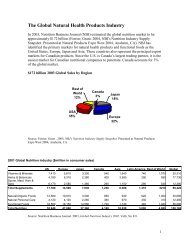Beyond Borders: Global biotechnology report 2010
Beyond Borders: Global biotechnology report 2010
Beyond Borders: Global biotechnology report 2010
Create successful ePaper yourself
Turn your PDF publications into a flip-book with our unique Google optimized e-Paper software.
“For most of the history of the biotech<br />
industry, licensing between pharma and<br />
biotech companies has largely flowed in<br />
one direction — from biotech to pharma.<br />
But things may now be poised for change.”<br />
driven by pharma companies’ constraints,<br />
as buyers are looking for ways to get more<br />
“shots on goal” with smaller R&D budgets.<br />
Big pharma companies that were active<br />
users of options-based transactions in 2009<br />
included GlaxoSmithKline (in deals with<br />
Vernalis, Prosensa, Chroma Therapeutics,<br />
Supergen, Concert Pharmaceuticals and<br />
others) and Novartis (in deals with Proteon<br />
and Elixir Pharmaceuticals). The structure<br />
was also popular with large <strong>biotechnology</strong><br />
companies, including Cephalon. (For more<br />
on these transactions, refer to the Deals<br />
article in this year’s <strong>Beyond</strong> borders.) In the<br />
new normal, biotech companies can expect<br />
more large buyers looking to construct<br />
deals using such options-based structures.<br />
In the challenging funding environment<br />
of the new normal, big pharma is more<br />
important than ever as a source of capital<br />
for biotech companies. But to succeed in<br />
partnering with pharma, biotech firms will<br />
need to actively track the changes taking<br />
place in the pharma industry. For instance,<br />
the recent wave of pharma-pharma megamergers<br />
— coupled with pharma companies’<br />
initiatives to assess strategic priorities<br />
and exit entire lines of business — has<br />
reduced the number of potential buyers<br />
for any given asset. In addition, as pharma<br />
companies grapple with the challenges of<br />
Pharma 3.0, they will increasingly need to<br />
partner with non-traditional players from a<br />
host of other industries.<br />
In recent years, as pharma companies<br />
have competed aggressively to license the<br />
most promising assets from biotech firms,<br />
many large firms have taken to describing<br />
themselves as the “partner of choice”<br />
for biotech — highlighting their positive<br />
attributes for potential biotech partners. In<br />
the new normal, biotech companies may<br />
instead need to ensure that they are the<br />
partners of choice for pharma. To do so,<br />
they may need to design their development<br />
efforts with buyers in mind and track shifts<br />
in pharma companies’ strategic priorities<br />
over time.<br />
But the changes under way in big pharma<br />
will also create many opportunities for<br />
biotech companies. Some of the biggest<br />
openings may be in the area of licensing.<br />
For most of the history of the biotech<br />
industry, licensing between pharma and<br />
biotech companies has largely flowed in one<br />
direction — from biotech to pharma. But<br />
things may now be poised for change. As<br />
discussed above, many pharma companies<br />
are narrowing their therapeutic focus<br />
and will have less financial wherewithal<br />
to pursue everything in their labs in the<br />
years ahead. It is very likely that companies<br />
will out-license assets that they are unable<br />
or unwilling to develop internally. Pharma<br />
companies have sometimes been<br />
risk-averse in their attitudes toward<br />
out-licensing — preferring to hold on to<br />
something rather than give away the next<br />
big thing to a competitor. But now, with<br />
companies deciding that it is no longer<br />
10 <strong>Beyond</strong> borders <strong>Global</strong> <strong>biotechnology</strong> <strong>report</strong> <strong>2010</strong><br />
strategic for them to compete in certain<br />
spaces, pharma managers may be less<br />
reticent. This could create opportunities<br />
for investors that can pair promising<br />
clinical candidates with experienced<br />
entrepreneurial teams to commercialize<br />
these assets.<br />
The out-licensing trend will get an<br />
additional boost from the need to boost R&D<br />
efficiency. As a bottom-line focus further<br />
constrains research budgets, pharma<br />
companies will need to fundamentally revisit<br />
the cost-benefit of their R&D expenditures<br />
and search intensely for the most<br />
efficient means of pursuing their product<br />
development goals. As they<br />
do so, it is quite likely that some firms will<br />
see more efficiencies and higher returns<br />
from conducting a greater share of<br />
R&D — particularly in discovery and early<br />
clinical trials — in concert with external<br />
partners. In January <strong>2010</strong>, a widely<br />
read research <strong>report</strong> by Morgan Stanley,<br />
Pharmaceuticals: Exit Research and Create<br />
Value, argued that pharma companies<br />
could earn better returns by reducing their<br />
reliance on internal research.<br />
The wave of out-licensing will also create<br />
opportunities for investors and biotech<br />
entrepreneurs, spawning new start-ups and<br />
creative business models. It is not surprising<br />
that Michael Clayman explicitly addresses<br />
the opportunities latent in pharma’s move<br />
to exit therapeutic areas when discussing<br />
Flexion’s growth potential.<br />
This trend will be boosted by the growth<br />
of “open innovation” approaches. As big<br />
pharma companies look to do things more<br />
efficiently, they are moving well beyond the<br />
historic “not invented here” mentality to<br />
collaborate in new, increasingly open ways.<br />
In recent years, we have seen companies








